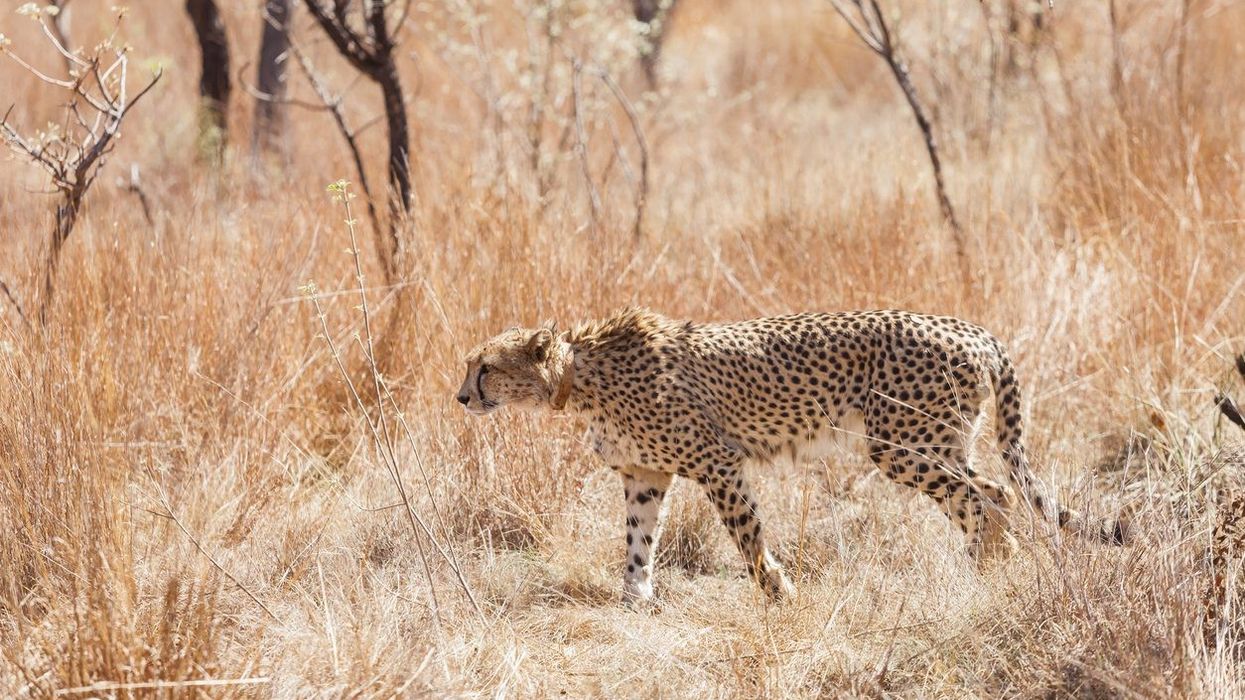The ninth cheetah died at the Kuno National Park in Madhya Pradesh, India on Wednesday (02), a statement from the state forest department said. The recent death marks another loss for the feline population since March.
"We are examining the death...the cause of death will be known after the post-mortem," principal chief conservator of forest (wildlife) Aseem Shrivastava said.
International experts involved in Project Cheetah have said the natural process of cheetahs developing thick coats of fur in anticipation of African winter appears to be proving fatal in India's wet and hot conditions.
In a report to the government, they suggested interventions such as shaving off the winter coats to deal with fatal infections and prevent any more death.
The experts said that the thicker coats, high parasite load and moisture create a perfect recipe for dermatitis with fly strike on top of it compounding the infection and compromising the skin's integrity.
Infections can spread and the contaminated fluids can run down the spine when the cheetahs sit up on their haunches, they said.
However, a government official associated with the project said that not all the felines have developed thicker coats.
"Some of these cheetahs who do not have long hair are not facing such issues. So, it's natural selection. The fittest of them and their offsprings will survive and thrive in the Indian conditions," the official said on condition of anonymity.
In their report submitted to the government recently, the experts said that adapting on an "evolutionary timescale" might be the only permanent solution if there's a genetic link to the development of winter coats.
However, the report notes that climate itself is not a significant limiting factor for cheetahs as their historical range extends from southern Russia to South Africa, overlapping with various climatic zones.
Data from 364 metapopulation relocations between 2011 and 2022 also indicate that climate is not a major hindrance to cheetah survival, according to the research cited in the report.
Regarding the frenzy surrounding the cheetah deaths, the official said the mortalities are well within the accepted range and that such translocations have faced challenges in the past too.
"There will be challenges but we expect the cheetahs to learn and adapt. That will be the true reintroduction of the species in India," the official added.
Under the much-vaunted Project Cheetah, a total of 20 animals were imported from Namibia and South Africa to the KNP in two batches -- one in September last year and the second in February this year.
Since March, six of these adult cheetahs have died due to various reasons.
In Kuno, fourteen cheetahs are kept in enclosures, consisting of seven males, six females, and a female cub. Their health is regularly monitored by a team of Kuno wildlife veterinarians and a Namibian expert.
Presently, one female cheetah is being closely monitored while roaming in the open, and efforts are being made to bring her back to an enclosure for a thorough health examination, authorities said.
Last month, two South African male cheetahs, Tejas and Suraj died due to infection in wounds caused by the radio collars around their necks. However, the environment ministry said all cheetah deaths were due to natural causes.
Three Namibian male cheetahs -- Pawan, Gaurav, and Shaurya -- and two females -- Aasha and Savannah -- were subsequently found having similar skin infections.
An expert veterinarian from South Africa cleaned up the wounds.
Experts involved in the cheetah reintroduction project had told PTI that heavy rain, extreme heat, and humidity may have caused the problems, "with the collars fitted around the necks of the cheetahs potentially causing additional complications".
Although experts suggest shaving off the winter coats to deal with the issue and prevent more deaths, there are concerns about the potential risks of administering medicine, involving darting, capturing and returning the cheetahs to enclosures.
Such actions may lead to stress and mortality risks, impacting the cheetahs' adjustment to their new habitat.
Research shows cheetah immobilisation carries a high risk of mortality and the extreme stress prevents the cheetahs from settling into their new habitat.
Ravi Chellam, wildlife expert and coordinator of Biodiversity Collaborative, Bengaluru, called for stopping the import of more cheetahs, considering the challenges faced in India.
All the cheetahs have been administered Fluralaner, a systemic insecticide and acaricide given orally or topically.
There could be a need to repeat the treatment before the monsoon season next year to reduce parasite loads until the animals develop a sufficient level of immunity, the experts said.
Under the Cheetah Reintroduction Project, eight Namibian cheetahs -- five female and three male -- were released into enclosures at KNP on September 17 last year.
In February, 12 more cheetahs arrived at KNP from South Africa.
Later, four cubs were born to the Namibian cheetah 'Jwala' in March, but three of them died in May due to extreme heat. The remaining cub is being hand-raised for future wildling.
During the monitoring process, no wire snares or gin traps, which have posed significant threats to cheetahs in reintroduction projects within African protected areas, have been discovered, indicating a promising outlook for the well-being of the cheetah population.
Additionally, the park has a high leopard density, with an estimated 90 individuals inhabiting the 74,200-hectare area, but this has not had a negative impact on the cheetah reintroduction.
However, experts have observed a Phinda male coalition treeing a male leopard on one occasion, suggesting potential interactions between the two species.
As a precautionary measure, efforts are being made to anticipate any possible cheetah losses to leopards, particularly when cubs are born.
Cheetahs were reintroduced in India 70 years after the extinction of the species in the wild in the country.
(PTI)






 Holiday fans celebrate Leona Lewis' One More Sleep topping the UK streaming charts Youtube Screengrab
Holiday fans celebrate Leona Lewis' One More Sleep topping the UK streaming charts Youtube Screengrab 






